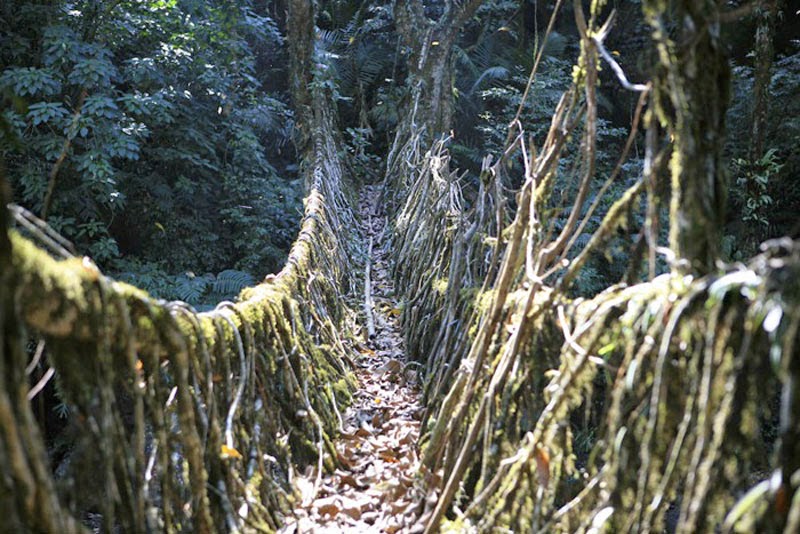
The lower reaches of the southern slopes of the Khasi and Jaintia hills in Northeastern India is one of the wettest regions in the world, featuring a humid and warm climate with many fast flowing rivers and mountain streams.
Yet it’s also home to an astounding site. Over the years, the people living there have come up with their own amazing method of natural engineering, using living root bridges.
Thriving and flourishing on the slopes of the hills, amongst the dense undergrowth, is a species of Rubber tree (Ficus Elastica). It’s a large tree in the banyan group of figs, and it grows up to 30-40 meters (98-131 feet) tall (in rare cases up to 60 meters (200 feet) tall) with a stout trunk of up 2 meters (6.6 feet) in diameter.
The tree develops aerial roots (roots above the ground) and buttress roots (large roots on all sides of a shallow rooted tree) that anchor into the soil to support its heavy branches.

The tree also shoots many secondary roots from higher up on the trunk.
These secondary roots allow the trees to comfortably perch themselves on top of huge boulders near the sides of riverbanks or in the middle of the rivers as they send their roots down into the riverbed.
The ancient War-Khasai people, a tribe in Meghalaya, noticed the amazing qualities of the rubber trees and came up with an ingenious way of getting around. Given that the area is one the wettest places on Earth, the rivers can often be rather dangerous to cross.

In response to their need for reliable bridges across the bodies of waters, they adapted and used the trees.
The War-Khasai people use betel nut trunks, which have been sliced down the middle and hollowed out, to form the crossings.
They thread the long thin tendrils through the trees to create a type of root-guidance system. The betel nut trunks prevent the tender roots of the rubber tree from fanning out, instead growing in one straight direction towards the other end of the stream. When they reach the other side, they’re allowed to take root into the soil.

After enough time, a sturdy, living bridge is produced. It usually takes about 10-15 years for the bridges to become fully functional, but they keep growing in strength every day. They can be over 100 feet long and are incredibly strong, some of the bridges able to carry 50 or more people at one time.
Certain bridges are well over 500 years old, but are still very sturdy and usable. Because the bridges are self-enforcing, they don’t grow weak over time, they only grow stronger.
These living bridges are unique to Meghalaya and, even today, are still used daily by people living in the many villages around Cherrapunjee. One well-known bridge is composed of two bridges stacked over one another.
It’s located at the bottom of a valley in Nongriat where the villagers call it “Umshiang Double Decker Root Bridge”. While, it’s certainly an amazing bridge, all of the living root bridges are completely remarkable.

Source: Earth Porn
Related Posts:


0 comments:
Post a Comment